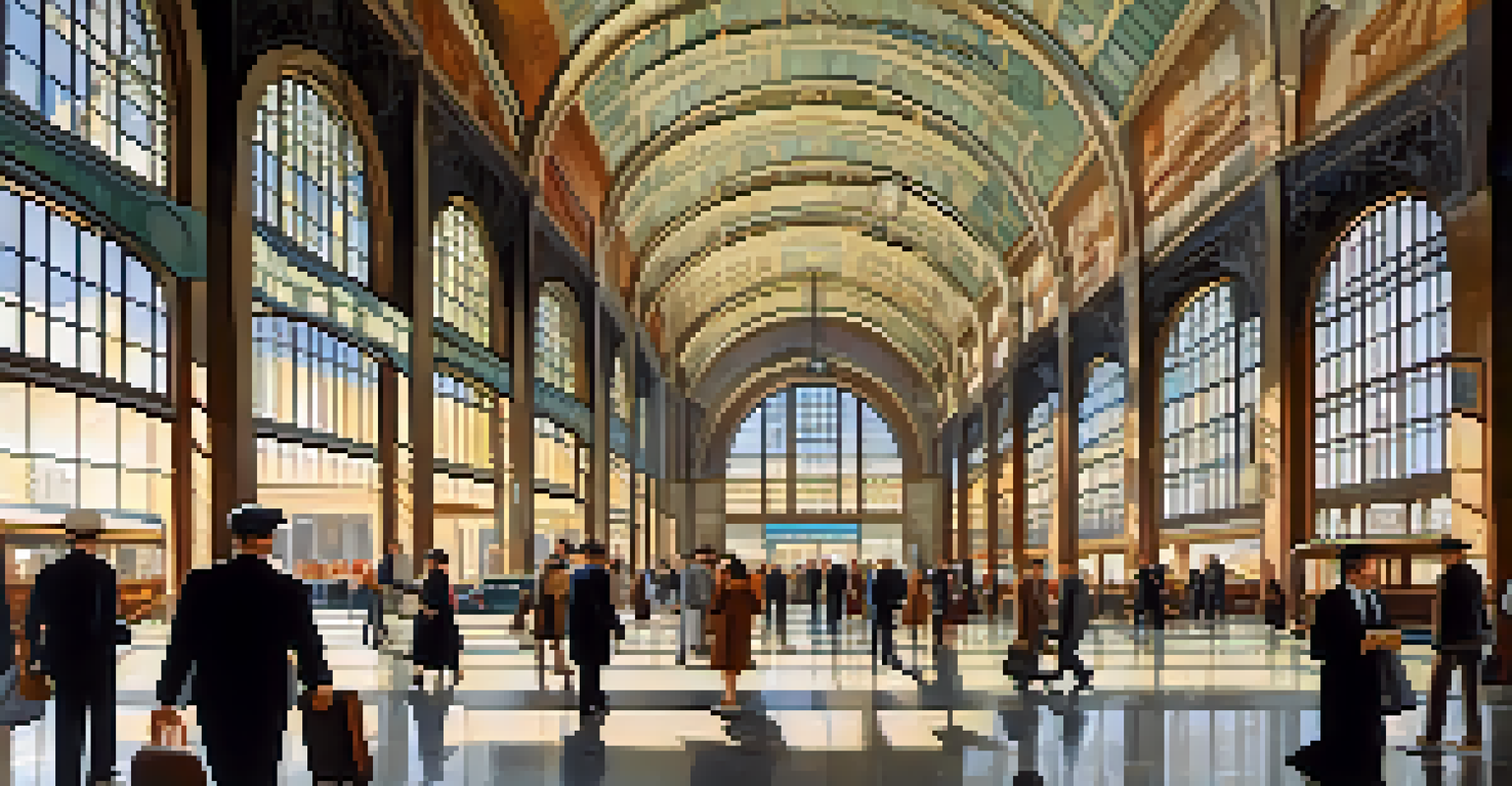The Historical Significance of Buffalo's Railway Stations

Buffalo's Early Railway Development and Its Impact
In the mid-19th century, Buffalo emerged as a pivotal transportation hub. The establishment of railroads transformed the city from a small trading post into a bustling metropolis. Enhanced connectivity allowed for easier movement of goods and people, spurring economic growth and attracting industries.
Transportation is the backbone of our economy, and railroads have been a vital part of that structure, connecting people and places.
The Erie Canal, completed in 1825, laid the groundwork for railway expansion. By connecting the Great Lakes to the Atlantic Ocean, it made Buffalo a key shipping point. This early infrastructure set the stage for the railroads that would soon crisscross the city, linking it to major markets.
As railroads continued to develop, Buffalo became known as the 'Gateway to the West.' The influx of settlers and business opportunities created a vibrant community, showcasing how transportation can shape a city’s destiny.
Architectural Marvels: The Design of Railway Stations
Buffalo's railway stations are not just functional; they are architectural masterpieces. The design of these stations reflects the grandeur and optimism of the era they were built in. With their intricate details and imposing structures, they serve as a testament to the city’s historical significance.

Take, for example, the Central Terminal, completed in 1929. This Art Deco gem features stunning vaulted ceilings and beautiful murals, embodying the hope and ambition of the time. Such design choices were not just aesthetic; they also represented the importance of rail travel in connecting people and places.
Buffalo's Railway Transformed Economy
The establishment of railroads in Buffalo catalyzed economic growth by connecting local industries to national and international markets.
These stations were often the first impression of Buffalo for travelers, showcasing the city's commitment to progress. Their architectural significance continues to attract attention, making them a focal point for both history buffs and tourists alike.
Cultural Impact of Buffalo’s Railway Stations
Beyond transportation, Buffalo's railway stations played a significant cultural role. They served as gathering places, where stories were shared and connections were made. This sense of community fostered a unique cultural identity that still resonates today.
The preservation of our historical sites is not just about saving buildings; it's about preserving the stories and memories that define our communities.
Events such as fairs, concerts, and exhibitions often took place at these stations, enriching the local culture. The hustle and bustle of travelers created a vibrant atmosphere, reflecting the diverse backgrounds and experiences of those passing through.
This cultural melting pot also influenced local arts and traditions. The railway stations became a backdrop for artistic expression, with murals and performances celebrating the city’s rich heritage and ongoing evolution.
Economic Influence of the Railway System
The economic implications of Buffalo's railway stations are profound. They facilitated trade by connecting local industries with national and international markets. The ease of transportation allowed businesses to thrive, laying the foundation for Buffalo’s economic landscape.
Railroads brought jobs to the area, not just in transportation but also in manufacturing and services. As industries expanded, Buffalo became a center for commerce, attracting workers and entrepreneurs eager to seize new opportunities.
Architectural Significance of Stations
Buffalo's railway stations are not only functional but also architectural masterpieces that reflect the city's historical significance and cultural identity.
This economic boom led to urban development, with neighborhoods and businesses sprouting around the railway stations. As a result, these stations became anchors of economic activity, shaping the growth and prosperity of the city.
The Decline and Revival of Buffalo's Railway Stations
Like many cities, Buffalo's railway stations faced decline in the latter half of the 20th century. With the rise of automobiles and air travel, train travel saw a significant drop, leading to the deterioration of many railway facilities. This shift left behind empty buildings, raising concerns about preservation.
However, in recent years, there has been a renewed interest in revitalizing these historic stations. Community efforts and investments have aimed to restore their former glory, turning them into vibrant spaces for public use and community events.
This revival not only preserves history but also breathes new life into the neighborhoods surrounding these stations. By embracing their historical significance, Buffalo aims to create a future where the past and present coexist harmoniously.
Preservation Efforts for Buffalo's Railway Stations
Preserving Buffalo's railway stations is crucial for maintaining the city’s historical narrative. Various organizations and local governments have taken steps to protect these architectural treasures, recognizing their cultural and historical value. Efforts include restoration projects and advocacy for historical designations.
The National Register of Historic Places has listed some of these stations, ensuring that they receive the attention they deserve. Grants and funding have also been allocated to support restoration, allowing for necessary repairs and maintenance.
Revival Efforts for Historic Stations
Recent community preservation initiatives aim to revitalize Buffalo's historic railway stations, blending their rich past with modern utility and engagement.
These preservation efforts not only safeguard the physical structures but also keep the stories and memories alive. They provide future generations with a glimpse into the city’s past, fostering a sense of pride and connection to Buffalo’s rich history.
Community Engagement and Educational Programs
Engaging the community in the history of Buffalo's railway stations is vital for fostering appreciation. Local schools and organizations have developed educational programs that highlight the significance of these stations. By involving students and residents, they help cultivate a sense of ownership and pride in their heritage.
Workshops, guided tours, and interactive exhibits allow people to explore the stories behind these historic sites. Such initiatives not only educate but also encourage dialogue about the importance of preservation and the role of transportation in shaping communities.

Through these efforts, the railway stations become living history, where the community can connect with their past. This engagement ensures that the narrative of Buffalo's railway legacy continues to thrive and evolve.
The Future of Buffalo's Railway Stations
Looking ahead, the future of Buffalo's railway stations appears promising. With ongoing preservation and revitalization efforts, these historic sites are poised to play a vital role in the city's urban landscape. The combination of historical significance and modern utility can create vibrant community hubs.
As cities increasingly prioritize sustainable transportation, the revival of railway travel presents new opportunities. Buffalo's railway stations could become integral parts of a broader transportation network, connecting residents and visitors alike to essential services and attractions.
Ultimately, the future of these stations hinges on community involvement and continued investment. By embracing their historical significance while adapting to modern needs, Buffalo can ensure that its railway stations remain a vital part of its identity for generations to come.